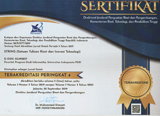Implementasi Algoritma K-Means untuk Menganalisa Pemain Video Game Mobile Legend untuk Mengetahui Tipe Hero dan Role yang Sering Digunakan pada Setiap Kalangan
(1) Universitas Semarang
(2) Universitas Semarang
(3) Universitas Semarang
(4) Universitas Semarang
(*) Corresponding Author
Abstract
Video games are one of the technologies in the entertainment field that are growing rapidly in the community. Even Esports (video game competitions) are increasingly recognized by the industry as a recreational sport. An example of an esport that is currently popular among people is Mobile Legends. Both Android and IOS smartphones can run the Mobile Legends video game application. However, no one has ever discussed using the developer's built-in Role-playing as an alternative hero to simplify the Role-playing combination guide in the game, grouping characters according to their characteristics, and using characters according to the player's wishes. For this reason, this study uses the k-means algorithm to compile the grouping of heroes and Role-playing in the Mobile Legend video game. From the results of the research conducted, there are three groups of heroes that have similar characteristics, namely Mage, Marksman, and Fighter. The K-Means algorithm used can help determine the order of hero launches. Based on the results of clustering testing using the K-Means method, data in cluster 1 was obtained with an average accuracy of 5% hero support; heroes Tanks 10%; Fighter heroes 20%; hero Mage 25%; hero Assassin 20%; Marksman heroes 20%; then for the average age of 25.1 ; win rate 67.3; total matches 5863.4 and total MVP 1664,1. Players with hero support, tank, fighter and mage types have Roles as supporting tools to develop a core Role or Marksman and assassin heroes who have high capabilities as winners in the team, with an average user who has a supporting Role of 0.15 and an average user with 0.2 . Role core
Keywords
Full Text:
PDFReferences
G. R. F. Wicaksana, G. Susilo, and T. Yusnanto, “Rancang Bangun Role Playing Game (RPG) Bertema Mobile Legends : Bang Bang,” J. Transform., vol. 16, no. 2, pp. 42–52, 2020, [Online]. Available: https://ejournal.stmikbinapatria.ac.id/index.php/JT/article/view/225.
M. Mustofa, “Penerapan Algoritma K-Means Clustering pada Karakter Permainan Multiplayer Online Battle Arena,” J. Inform., vol. 6, no. 2, pp. 246–254, 2019, doi: 10.31311/ji.v6i2.6096.
D. Kurniadi and A. Sugiyono, “Pengelompokkan Data Akademik Menggunakan Algoritma K-Means Pada Data Akademik Unissula,” J. Transform., vol. 18, no. 1, p. 93, 2020, doi: 10.26623/transformatika.v18i1.2277.
M. Mardalius, “Pemanfaatan Rapid Miner Studio 8.2 Untuk Pengelompokan Data Penjualan Aksesoris Menggunakan Algoritma K-Means,” Jurteksi, vol. 4, no. 2, pp. 123–132, 2018, doi: 10.33330/jurteksi.v4i2.36.
A. Taufik, “Sistem Informasi Inventory (SITORY) Berbasis Web Dengan Metode Framwork For The Application System Thinking (FAST ),” JATISI (Jurnal Tek. Inform. dan Sist. Informasi), vol. 8, no. 2, pp. 859–869, 2021, doi: 10.35957/jatisi.v8i2.930.
D. Andriyani, E. Harahap, F. H. Badruzzaman, M. Y. Fajar, and D. Darmawan, “Aplikasi Microsoft Excel Dalam Penyelesaian Masalah Rata-rata Data Berkelompok Microsoft Excel Application in Solving The Average of Group Data Problems,” J. Mat., vol. 18, no. 1, pp. 41–46, 2019.
R. C. Dhewy, “Pelatihan Dasar-Dasar Statistika Dengan Menggunakan Aplikasi Microsoft Excel Di Sdn Pamotan Ii Kecamatan Porong,” J. PADI – Pengabdi. Masy. Dosen Indones., vol. 1, no. 1, pp. 36–40, 2018.
Y. Prastyo, P. Eosina, and F. Fatimah, “Pembagian Tingkat Kecanduan Game Online Menggunakan K-Means Clustering Serta Korelasinya,” 2010.
R. K. Dinata, H. Akbar, and N. Hasdyna, “Algoritma K-Nearest Neighbor dengan Euclidean Distance dan Manhattan Distance untuk Klasifikasi Transportasi Bus,” Ilk. J. Ilm., vol. 12, no. 2, pp. 104–111, 2020, doi: 10.33096/ilkom.v12i2.539.104-111.
Y. Miftahuddin, S. Umaroh, and F. R. Karim, “Perbandingan Metode Perhitungan Jarak Euclidean, Haversine, Dan Manhattan Dalam Penentuan Posisi Karyawan,” J. Tekno Insentif, vol. 14, no. 2, pp. 69–77, 2020, doi: 10.36787/jti.v14i2.270.
M. Anggara, H. Sujiani, and N. Helfi, “Pemilihan Distance Measure Pada K-Means Clustering Untuk Pengelompokkan Member Di Alvaro Fitness,” J. Sist. dan Teknol. Inf., vol. 1, no. 1, pp. 1–6, 2016.
DOI: http://dx.doi.org/10.30998/string.v6i3.11094
Refbacks
- There are currently no refbacks.
Copyright (c) 2022 Laras Elza Devila, Saifur Rohman Cholil, Raffi Danendra Athallah, Ahmad Arrio Irawan

This work is licensed under a Creative Commons Attribution 4.0 International License.
STRING (Satuan Tulisan Riset dan Inovasi Teknologi) indexed by:

Ciptaan disebarluaskan di bawah Lisensi Creative Commons Atribusi 4.0 Internasional.
View My Stats


 Sertifikat Akreditasi
Sertifikat Akreditasi
















